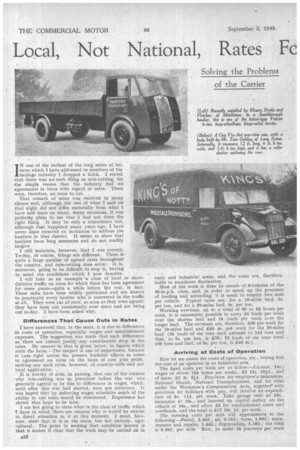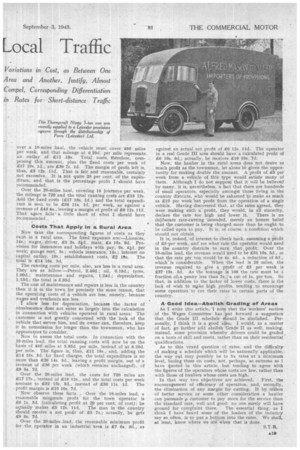Local, Not N ation a Rates Fc Local Traffic
Page 20

Page 21

If you've noticed an error in this article please click here to report it so we can fix it.
Variations in Cost, as Between One Area and Another, Justify, Almost Compel, Corresponding Differentiation in Rates for Short-distance Traffic
/ N one of the earliest of the long series of lec tures which I have addressed to members of the haulage industry I dropped a brick. I stated that there was ncr such thing as rate-cutting, for the simple reason that the industry had no agreements in force with regard to rates. There were, therefore, no rates to cut.
That remark of mine was received in stony silence and although the rest of what I said on that night did not differ materially from what I have said since on many, many occasions, it was perfectly plain to me that I had not done the right thing. It may be only a coincidence but, although that happened many years ago, I have never since 'received an invitation to address the hauliers in that district. It seems to show that hauliers have long memories and do not readily forgive I still Maintain,, however, that I was correct. To-day, of course, things are different. There is quite a large number of agreed rates throughout the country, and rate-cutting does occur. It is, moreover, going to be difficult to stop it, having in mind the conditions which I now describe.
I will take as an example -a class of local or shortdistance traffic on rates for which there has been agreement for some years—quite a while before the war, in fact. These rates have been widely publicized and are known to practically every haulier who is interested in the traffic at all. They were cut at once; so soon as they were agree-d; they have been cut consistently ever since and are being cut to-day. 1 have been asked why.
, . .
Differences That Cause Cuts in Rates , I have answered that, in the main, it is due to differences in costs of operation, especially wages and establishment expenses. The suggestion was made that such differences as there are cahnot justify any considerable drop in the rates, My answer to that is given below, in figures which state the facts. • The subject is one of importance, because it cuts right across the present laudable efforts to cometo agreement on rates on the basis of cost plus profit, making any such rates, however, of country-wide and not local application. , .
It is worthy of note, in passing, that one of the reasons" why rate-cutting was 'so prevalent before the war was generally agreed to be due to differences in wages, which, until after this war had started, were not statutory. It was hoped that by enforcing wages schedules much of the ability to cut rates would be eliminated, Experience has shown that hope to be false. . I am not going to state what is the class of traffic which i have in mind; there are reasons why it would be unwise to direct attention to it at this moment. I must, however, state that it is in the main, but not entirely, agricultural. The point in making that condition known is that it makes it clear that the work may be carried on in rural and industrial areas, and the costs are, therefore, liable to maximum fluctuation.
Most of the work is done by means of 6-tonners of the 30-m.p.h. class, and, in order to speed up the processes of loading and unloading; it is usual to employ two men per vehicle. Typical -rates are for a 10-miles lead, 5s. per ton, and for a 20-miles lead, Ss. per ton. . Working overtime, up to a total of 60 to 64 hours per week, it is reasonably possible to carry 24 loads per week over the shorter lead and 18 loads 'per week over the longer lead. The revenues are, therefore, £36 per week for the 10-miles haul and £43 4s, pet week for the 20-miles haul (24 loads of six tons each amount to 144 tons and that, at 5s. per ton, is £36; 18 loads of six tons total 108 tons and that, at Sc. per ton, is £43 4s.), Arriving at Costs of Operation Now let me assess the costs of operation, etc., taking first the case of an operator in an industrial area. The fixed costs per week are as follow:—Licence, I4s.; wages of driver "(64 hours per week), £5 15s. 100., and of mate, £5 3s. 3id. Provision for-employee's insurances, National Health, National Unemployment, and for risks under the Workmen's Compensation Acts, together° with provision for holidays with pay, will involve an -expenditure of 9s. 11d, per week. Take garage rent at 10s., insurance at 16s., and interest on capital outlay on the vehicle at 10s., and allow £4 for establishment costs and overheads, and the total is £17 19s. Id. per week.
The running costs per mile will approximate to .the following:—Petrol, 2.40d.; oil, 0,18d.; tyres, 1.00d.; maintenance and repairs, 1.44d.; depreciation, 1.18d.; the total is 6.20d. per mile. Now, to make 24 journeys per. week
over a 10-miles haul, the vehicle must cover 480 miles per week, and that mileage at 6.20d, per mile represents an outlay of £12 18s. Total costs, irherefore, comprising this amount, plus the fixed costs per week of 217 I9s. ld., arc £30 7s. ld. The margin of profit left is, thus, £5 12s. 11d. That is fair and reasonable, certainly not excessive. It is not quite 20 per cent. of the expenditure, and that is the percentage profit I should have recommended.
Over the 20-miles haul, covering 18 journeys per week, the mileage is 720 and the total running costs are 218 12s. Add the fixed costs (217 19s. id.) and the total expenditure is seen to be £36 us. Id. per week, as against a revenue of 243 4s., leaving a margin of profit of £6 12s. lid. That again fallsa little short of what I should have recommended.
Costs That Apply in a Rural Area
Now take the corresponding figures of costs as they exist in a rural area. The fixed expenses are:-Licences, 14s.; wages, driver, 25 3s. 34c1., mate, £4 10s. 9d. Provision for insurances and holidays with pay, 9s, 41d. per week; garage rent, 5s.: vehicle insurance, I4s.; interest on
capital outlay, 10s.; establishment costs, £2 16s. The total is 214 143s. 5d.
The running costs per mile, also, are less in a rural area. They are as follow:-Petrol, 2.40d.; oil, 0.18d.; tyres, 1.00d.; maintenance • and repairs, 1.24d.; depreciation, 1.13d.; the total is 5.95d.
The cost of maintenance and repairs is less in the country than it is in the town for precisely the same reason, that the operating costs of a vehicle are less, namely, because wages and overheads are less. • I allow less for depreciation, because the factor of obsolescence does not enter so largely into the calculation in connection with vehicles operated in rural areas. The customer is not greatly concerned with the look of the vehicle that serves him, and its owner can, therefore, keep it in commission for longer than the townsman, who has _ appearances to consider.
Now to assess the total costs. In connection with the 10-miles lead, the total running costs will now be on the ' basis of 486 miles at 5.95d. per mile, instead of at 6.20d. per mile. The figure is, thus, 211 18s., and, adding the £14 16s. 5d. for fixed charges, the total expenditure is no more than £26 14s. 5d., leaving a profit margin, out of a revenue of £36 per week (which remains unchanged), of £9 5s. 7d.
Over the 20-miles lead, the costs for 720 miles are 217 17s., instead of 218 12s., and the total costs per week amount to 232 •13s. 5d., instead of 236 11s. ld. The profit margin is 210 10s. 7d. • •
Now observe these facts... Over the I0-miles lead, a reasonable minimum profit for the town operator is 26 is. 5d. (calculating profit at 2,0 per cent, of cost); he actually makes 25 12s, lid. The man in the country should receive a net profit of £5 7s.; actually, he gets £9 5s. 7d.
Over the 20-miles ,lead, the reasonable minimum profit for the operator in an industrial area is 27 6s. 3d., as against an actual net profit of £6 I2s. lid. The operator in a real Grade III area should have a Calculated profit of 26 10s. 8d,; actually, he receives 210 10s. 7d.
Now, the haulier in the rural areas does not desire as much profit as the townsman, let alone be given the opportunity for making double the amount. A profit of 25 per week from a vehicle of this type. would satisfy many of them. Although I do not suppose that it will be believed by many, it is, nevertheless, a fact that there are hundreds of small operators, especially amongst those living in the country districts, who would be ashamed to make as much as 210 per week 'net profit from the operation of a single vehicle. Having discovered that, at the rates agreed, they were making such a profit, they would, in all sincerity,
declare the rate too high and lower it. There is no deliberate rate-cutting intended, merely an honest belief that the customer is being charged more than he ought to be called upon to pay. It is, of course, a condition which should not obtain.
It is, indeed, of interest to check back, assuming a profit of £5-per week, and see what rate the operator would need in the country districts to earn ,that profit. Over the 10-miles lead, the revenue would need to be 231 10s. 5d., so that the rate per ton would be 4s. 4d., a reduction of 8d., which' is considerable. When the lead is 20 miles, the revenue required to give a profit of 25 per week is £37' 13s.. 5d. As the tonnage is 108 the rate must be a fraction of,a penny less than 7s., a cut of Is. per ton. So that, in addition to the factor of lower costs, there is the lack of wish to make high profits, tending to encourage some operators to cut their rates in certain parts of the country.
A Good Idea-Abolish Grading of Areas
As I write this article, I note that the workers' section of the Wages Committee has put forward a suggestion that the Grade III schedule should be abolished. Personally, I think it is a good idea. I would, as a matter of fact, go farther and abolish Grade II as well, making, instead, some provision whereby drivers could be graded on a basis of skill and merit, rather than on their residential qualifications.
As to this vexed question of rates, and the difficulty of making a schedule which will be. nationally appliCable, the way out may possibly be to fix rates at a minimum level, basing them on costs, not, perhaps, so extreme as I have quoted in this article, but tending to agree with the figures of the operators whose costs are low, rather than with those of hauliers whose costs are high.
In that way two objectives are achieved. First, the encouragement of efficiency of operation, and, secondly, the elimination of any margin for cutting. If by reason of .better service or some other consideration a haulier can pursuade t customer to pay more for the service than the 'standard rate, well and good: no one surely will have ground for complaint there. The essential thing, as I think I have heard some of the leaders of the industry say so often, is to put a bottom into the rates. We shall, at least, know where we are' when that is done.




















































